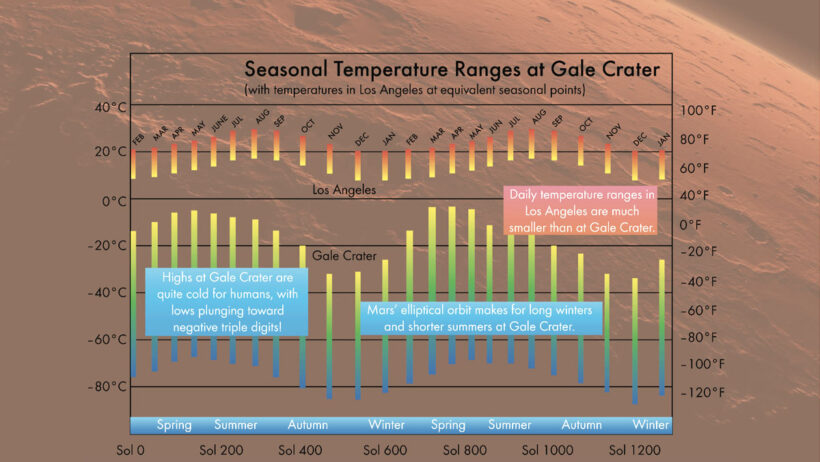The climate on Mars is a subject of immense intrigue and speculation. Often referred to as the “Red Planet,” Mars presents an extreme environment starkly different from our own Earth. So, what lies beneath the surface of this enigmatic world? Can centuries of frozen secrets unveil answers about our universe and the potential for life beyond our blue planet? As we delve into the characteristics of Martian climate, we shall explore its beguiling mysteries and tackle some formidable challenges along the way.
The first distinctive feature of Mars’s climate is its thin atmosphere, composed predominantly of carbon dioxide (about 95%). This tenuous envelope allows radiation from the sun to penetrate more readily, resulting in considerable diurnal temperature fluctuations. On a typical day, temperatures can soar to a moderate 70°F (20°C) near the equator but plummet to an inhospitable -195°F (-125°C) during nighttime, particularly at the poles. These extremes manifest starkly within the expanses of the Martian landscape, where some regions remain perpetually frozen, preserving clues to its ancient past.
One may ponder: how do such temperature variations affect Martian weather? The planet experiences weather patterns reminiscent of those on Earth—albeit less robust. Dust storms, in particular, are a hallmark of Mars’s climate. These colossal storms can envelop the entire planet, lasting for weeks and reshaping the terrain. Through these dynamic phenomena, red dust sweeps across the surface, creating a sepia-toned atmosphere that intricately interacts with sunlight, leading to intriguing optical effects. So, can these dust storms provide insights into the Martian climate’s broader patterns?
Moreover, water plays a pivotal role in the ongoing exploration of Mars’s climatic history. Evidence suggests that liquid water once flowed abundantly across the planet, etching riverbeds and creating expansive lake basins. Presently, Mars is believed to possess water primarily in frozen form, locked within polar ice caps or subsurface reservoirs. These icy stores are of paramount significance in discerning the climate evolution over millennia. Fascinatingly, recent discoveries hint at the presence of briny liquid water, potentially offering a lifeline for microbial life. However, the question remains: could this elusive water be the key to sustaining future human exploration?
The Martian environment is rife with challenges, and one of the most sophisticated is its gravity, which is only 38% that of Earth’s. This disparity complicates the retention of an atmosphere and contributes significantly to the planet’s arid conditions. In connection with its gravity, the solar wind has relentlessly stripped away the Martian atmosphere over billions of years. This atmospheric erosion presents a formidable challenge for future colonization efforts. What innovative strategies might we develop to replenish or sustain an atmosphere conducive to life?
Climate change on Mars is equally compelling. Although it does not possess the same human-induced issues shaping Earth’s atmospheric conditions, Mars’s climatic shifts over eons contribute to our understanding of climate dynamics across planetary bodies. The planet’s axial tilt—similar to Earth’s—creates seasons, and researchers have observed cyclical patterns in polar ice cap deposits. These cycles indicate that Mars has undergone substantial climate fluctuations, further complicating our attempts to elucidate its full climatic history. Could understanding these cycles shed light on climate systems elsewhere in the cosmos?
In contrast to our diverse ecosystems, Mars’s inhospitable nature presents a bleak tableau. Surface temperatures are far too frigid for life as we know it, and the piercing radiation poses substantial risks for any organisms attempting to survive. While Earth possesses a bountiful array of habitat types, Martian landscapes are dominated by dusty expanses and craggy canyons, posing considerable difficulties for biodiversity. Nevertheless, extremophiles—organisms that thrive in extreme conditions—offer tantalizing possibilities. If microscopic life once flourished on Mars, what lessons can modern environmentalists draw from its resilience amidst adversity?
The potential for terraforming—a concept referring to the transformation of a planet’s climate to make it habitable—presents captivating yet daunting challenges. Lifting Mars out of its frozen milieu into a welcoming haven requires seeding its atmosphere with greenhouse gases to instigate a warming effect. Hypothetical methods include the introduction of albedo-reducing materials or even deploying satellites to augment sunlight absorption. However, ethical considerations arise: should humanity undertake such monumental shifts, and at what potential cost? As we wrestle with these questions, the implications extend beyond Martian soil, prompting reflection on our stewardship of Earth.
In conclusion, Mars’s climate is an intricate tapestry woven from the threads of its thin atmosphere, extreme temperatures, and geological history. While the planet has long captivated human imagination, it also presents pressing inquiries about the potential for life, climate resilience, and the ethics of intervention. As scientists continue to unearth Martian secrets, the interplay between our understanding of Earth and other planets deepens, challenging us to contemplate the broader implications of climate science. In our quest to decipher Mars’s frosty enigmas, we position ourselves closer to resolving our conundrums on Earth, for within the secrets of the Red Planet lies valuable knowledge about the cosmos and ourselves.








